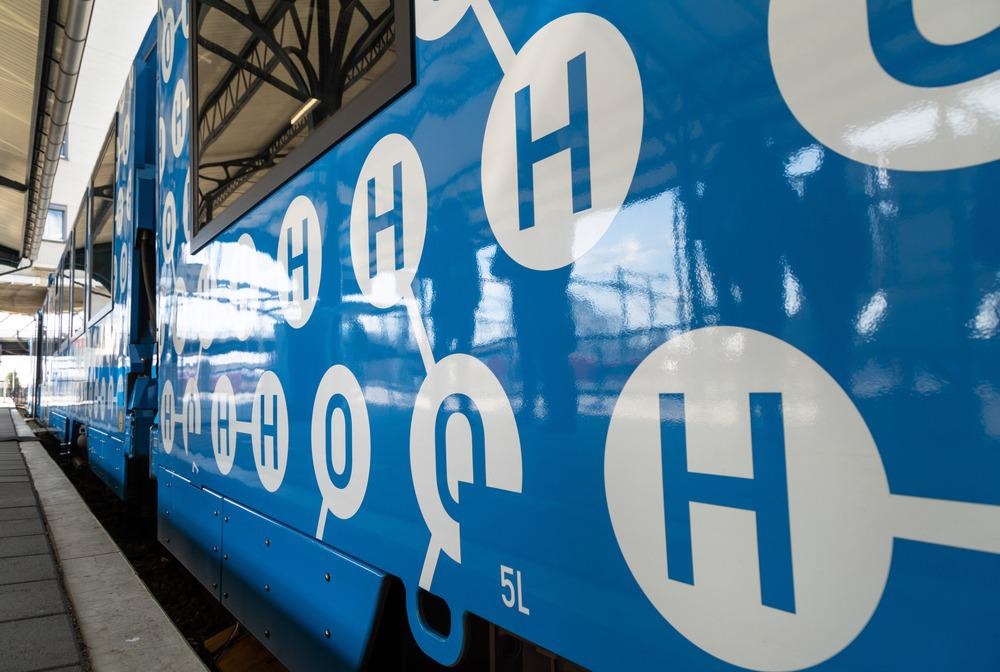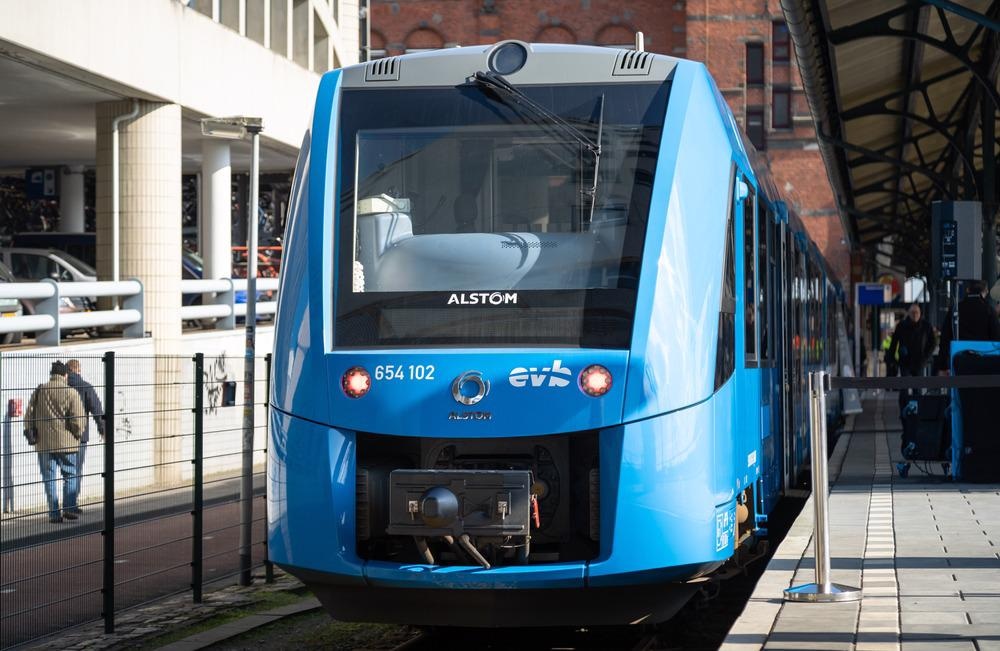
Image Credit: Sander van der Werf/Shutterstock.com
By the end of 2021, Scotland will be home to its first hydrogen-powered passenger train operating on its ScotRail.
A History of Hydrogen-Powered Trains
At the 2016 International Trade Fair for Transport Technology (InnoTrans), the innovative French transport company Alstom announced the world’s first hydrogen fuel cell passenger train known as the Coradia iLint.
Since its original introduction into the public marketplace, the Coradia iLint fleet of trains has been used for passenger service on the Buxtehude-Bremervorde-Bremerhave-Cuxhaven line in Germany, as well as in the Netherlands between the cities of Groningen and Leeuwarden.
As the world’s first regional passenger train to solely rely upon fuel cells that convert both hydrogen and oxygen into electricity, the Coradia iLint is a quiet and zero-emission transportation solution. To date, the Coradia iLint is capable of running for up to 600 miles on a single tank of hydrogen fuel, which is comparable to the distance that traditional trains can run on when using a single tank of diesel.
The success of the Coradia iLint inspired other engineers throughout Europe to also invest in the future of hydrogen fuel cells for their transportation needs. For example, in February 2020, the United Kingdom began running the HydroFlex, the first hydrogen-powered commuter train used in this nation. The HydroFlex is a joint effort between the University of Birmingham and Porterbrook, a British rail company.

The world's first hydrogen train was developed by the French transport company Alstom. Image Credit: Sander van der Werf/Shutterstock.com
How Does a Hydrogen-Powered Train Work?
The hydrogen fuel cell that powers the HydroFlex comprises an anode, cathode, and electrolyte membrane.
As stored hydrogen passes through the anode, it is split into electrons and protons. From here, the electrons are forced through a circuit that creates an electric charge that can either be stored for future use in a lithium battery or sent directly to the train’s electric motor to provide power in real-time to the moving train. Any remaining hydrogen that reacts with oxygen present within the cathode will generate water as its waste product.
Within the HydroFlex, hydrogen is stored in four secured high-pressure tanks underneath the train that amounts to approximately 20 kg of hydrogen fuel. The fuel cells' placement underneath the train ensures the passengers’ safety from this potentially explosive chemical and allows for more passenger space within the train itself.
A Zero-Emission Scotland
Scotland has previously announced its goal of reaching net-zero emissions by 2045. As of 2018, the transportation industry was responsible for 35.6% of the nation’s pollution emissions, causing this industry to remain Scotland’s largest emitting sector.
To reduce emissions released by this industry and move closer towards its 2045 goal, Scotland has invested its resources in decarbonizing all aspects of its transportation industry. For example, the decarbonization of the country’s passenger railway system is expected to be achieved by 2035, which is ten years earlier than its complete zero-carbon target date.
Bringing Hydrogen Trains to Scotland
To further advance its goal of complete decarbonization of all trains, Scotland has recently announced that by the end of 2021, it will have its first hydrogen-powered train. This collaborative effort will be supported by the Scottish Enterprise, Transport Scotland, and the Hydrogen Accelerator, which is based at the University of St. Andrews.
With this support, the Arcola Energy company and a group of international leaders in the railway engineering industry have been selected to develop the train’s new base's technology platform.
Like Arcola’s existing A-Drive platform, the new Scottish base will be designed according to all rail safety and compliance requirements.
Arcola Energy will also provide its experience in designing, engineering, and integrating hydrogel fuel cell systems into different transportation modes to the new Scottish train. Together with Arcola Energy, the global engineering consultant experts of Arup will also assist in the project by providing specialist rail engineering expertise.
Arup will be essential in determining appropriate technical concepts for the train and platform while maintaining a high-level design and safe employment strategy.
Like Arup, Abbott Risk Consulting, which has corporation bases in Edinburgh and Glasgow, will also be a part of this delivery team and function to ensure that all aspects of this project comply with national transportation, health, and safety regulations. AEGIS Certification Services will provide third-party safety certification and compliance verification of both the hydrogen-powered train and its associated infrastructure.
Future Directions
Scotland’s first hydrogen-powered train will be tested and based at the Bo’ness and Kinneil Railway and made available by ScotRail. Climate change enthusiasts are hopeful that this new development in Scotland will maximize the nation’s ability to meet its ambitious goal of emission-free passenger railways by 2035.
References and Further Reading
Alstom’s hydrogen train Coradia iLint completes successful tests in the Netherlands [Online]. Available from: https://www.alstom.com/press-releases-news/2020/3/alstoms-hydrogen-train-coradia-ilint-completes-successful-tests.
Next stop, hydrogen-powered trains [Online]. Available from: https://www.bbc.com/future/article/20200227-how-hydrogen-powered-trains-can-tackle-climate-change.
Arcola Energy and Consortium of Rail Industry Leaders to Deliver the First Scottish Hydrogen-Powered Train [Online]. Available from: https://pressat.co.uk/releases/arcola-energy-and-consortium-of-rail-industry-leaders-to-deliver-the-first-scottish-hydrogen-powered-train-4f6cb28d8d1600311ce5b3c569257d2a/.
Firms pledge to showcase Scotland’s ‘first’ hydrogen-powered train at COP26 [Online]. Available from: https://www.businessgreen.com/news/4025337/firms-pledge-showcase-scotland-hydrogen-powered-train-cop26.
Securing a green recovery on a path to net zero: climate change plan 2018-2032 – update [Online]. Available from: https://www.gov.scot/publications/securing-green-recovery-path-net-zero-update-climate-change-plan-20182032/pages/9/.
Scotland’s first hydrogen-powered train will run by the end of 2021 [Online]. Available from: https://www.lonelyplanet.com/articles/first-hydrogen-powered-train-scotland
Disclaimer: The views expressed here are those of the author expressed in their private capacity and do not necessarily represent the views of AZoM.com Limited T/A AZoNetwork the owner and operator of this website. This disclaimer forms part of the Terms and conditions of use of this website.